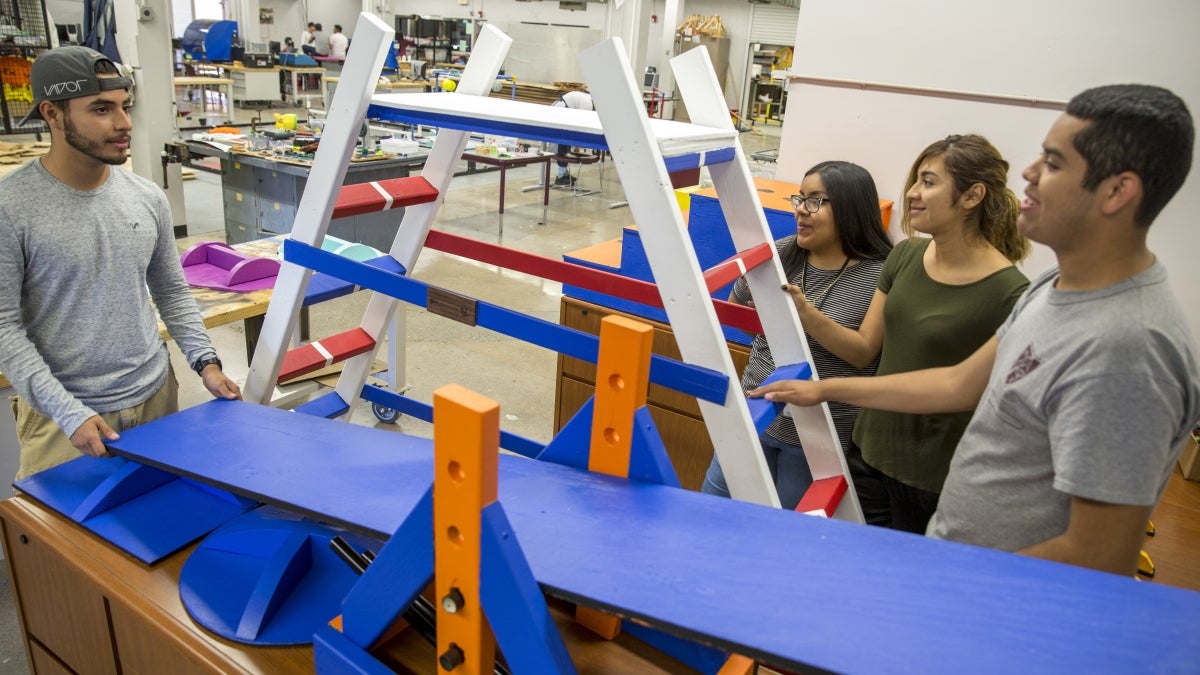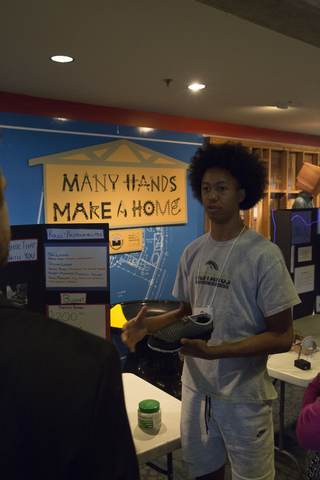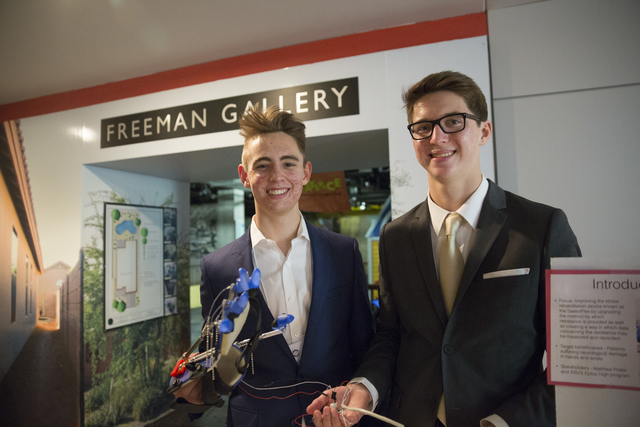EPICS High Showcase: Projects with purpose are motivating young students

Students at Metro Tech High School in Phoenix work on an obstacle course designed to train service dogs. It’s one of the projects that will be featured at the EPICS High Showcase on April 20 at the Arizona Science Center. Photo by Jessica Hochreiter/ASU.
"Engineers from day one" is the identity new undergraduates are encouraged to adopt in Arizona State University's Ira A. Fulton Schools of Engineering. The idea is to motivate students not to wait until they finish their schooling to actually do some real engineering.
Since 2008 many have embarked on that endeavor through the Engineering Projects in Community Service program — better known as EPICS — in which they help to solve real-world, engineering-based problems for local communities, municipalities and not-for-profit organizations.
Within about three years its success spawned EPICS High, which adapted the university model for high schools, and more recently for middle schools.
"We wanted to get that ‘engineers from day one’ idea out there even earlier for kids," said Jennifer Velez, the coordinator of the program.
“So many of them go through high school without understanding what engineering actually is and the impact it has,” she said. “We want to give them authentic engineering experiences.”
Success measured by human factors
EPICS High teams face the same challenges as college students.
“They have to gather input and get feedback from stakeholders in their communities to inform their decision making, so that by the end of their project timeline they can deliver a product or service that has real value. And they have to show that they developed a meaningful working relationship with their community partners,” Velez said.
The focus is on “human-centered” engineering design, meaning efforts measured not only by learning and applying technical know-how but by how the work improves peoples’ lives, explains Hope Parker, associate director of the Fulton Schools Pre-K-14 outreach program.
“Working with partners outside of the schools, understanding their needs and prototyping solutions, these things are at the core of what EPICS High is about,” Parker said. “It brings a bigger sense of purpose to what students are learning.”
The growth and success of the program will be in the spotlight on April 20, from 5 to 8 p.m. at the EPICS High Showcase at the Arizona Science Center in downtown Phoenix.
Exhibits will display students’ work on a wide range of community service projects undertaken by almost 60 student teams — more than double the number at last year’s Showcase event — from among the 25 high schools participating in the program.

EPICS High student teams are required to not only produce a viable product or provide a service, but also must collaborate with community partners to define needs and problems and develop effective solutions. Photo by Pete Zrioka/ASU
Developing skills and building character
Students at Metro Tech High School, a college preparatory school in the Phoenix Union High School District, are applying engineering skills to help clients of Circle the City, an organization that helps provide health care services to the homeless.
Circle the City told students they needed accommodations for the clients who travel to its facilities by bicycle.
Project team members met with the CEO of the company and later came up with several different iterations of their design for a bike rack, eventually presenting “an extremely tailored and unique bike rack solution,” says Metro Tech engineering teacher Stephanie Besch.
Other Metro Tech teams are developing agility courses to train therapy and rescue dogs, mobile therapy devices to aid children living with physical handicaps, and a regimen of physical activities for use by a physical education teacher who works with students with mental handicaps.
Students are learning teamwork, and how to effectively communicate and collaborate with project clients. They’re budgeting and developing prototypes. And, most importantly, working to help other people.
“Those are all incredibly valuable skills for college readiness and character development,” Besch said.
“I am super thrilled that I got my students involved in EPICS High,” she added. “It’s rewarding to see the pride on their faces as their projects come together and they realize that their hard work will benefit people. I don't think they ever believed their projects would come to fruition as they have. It's pretty awesome to see.”
Lessons about hard work, open minds
Matt Prater worked for 13 years in the pharmaceutical industry as a radiochemist before becoming a teacher.
Six years ago, he had a stroke and began using an exercise orthotic called a Saeboflex to work with his right hand.
A group of his students at Highland High School in Gilbert took on an EPICS High project to develop a device consisting of an Arduino (an electronics programming and prototyping platform based on easy-to-use hardware and software), force sensors, a liquid crystal display, batteries, 3-D-printed parts and a Wi-Fi adapter to add a quantitative component to the Saeboflex. All for less than $65.
“This allows us to measure the spasticity in the patient's arm and monitor the fatiguing of the spastic response as the patient exercises,” Prater explained.
“This will enable medical professionals to determine the best course of treatment, monitor patient repetitions from anywhere in the world, via the cloud, and provide patient response to treatment for the insurance company,” he said.
The team recently filed a provisional patent application for the device and are in talks with a company about a licensing agreement.
The effort has taught students about project management, electronics skills like soldering and wiring, writing computer programming code, project presentation and patent application filing.
“The big lesson I hope to provide is how real research gets done,” Prater said. “Not by clean steps always in the direction of the goal, but rather by grinding it out through hard work and an open mind, sometimes in two steps forward and one step back but hopefully not in one step forward and two steps.”

In addition to learning technical skills, EPICS High students gain experience in presenting their work and communicating their ideas to the public. Photo by Pete Zrioka/ASU
Fostering a legacy of accomplishment
An EPICS High team at Caesar Chavez High School in Laveen is developing light-up clothing with the purpose of preventing pedestrians from becoming victims of traffic accidents at night.
It’s intended to serve the many students who travel to the school in the dim light of early morning hours or are at the school late into the evening for sports activities, student club meetings or night-school classes, and don’t leave until after dark.
Teacher Michelle Myrann said the team “learned all about electricity, including Ohm's Law, parallel and series circuits, power and energy use, component analysis, and actual experimentation with circuits to obtain the effects desired by the stakeholders.”
They became adept at project management, documenting their work, and team collaboration.
“The current team leaders are now university bound, and they’ve started a legacy of accomplishment for our other students to continue,” Myrann said.
“We find kids like to have a say in choosing projects and in driving the relationship with community partners,” said Velez, an EPICS High coordinator.
“It’s different from your typical high school science project or research project because the highest level of accountability has nothing to do with the teacher or the grade you get,” she said. “The students are accountable to people who are really counting on them to deliver. And that is proving to be a strong motivator.”
Awarding innovation and impact
Some of the community partners of EPICS High teams will attend the showcase, along with ASU students who have experience in EPICS projects, industry representatives, donors and other supporters of the program.
The evening will conclude with an awards ceremony.
Awards are presented to teams that demonstrate exceptional teamwork and inventiveness, and whose projects have particularly valuable impacts on their communities.
There are also special Cisco Innovation Challenge awards given to student projects that demonstrate innovative ways to solve problems using digital technology and data-gathering devices.
Cisco Systems, a leading information technology and network systems company, is a major backer of EPICS High. The company's innovation award and other program support for is funded through its corporate philanthropy program set up by the Silicon Valley Community Foundation. EPICS High and ASU Entrepreneurship + Innovation are partners on the grant program.
The EPICS High Showcase gives high school students an opportunity to present exhibits on the engineering-based projects they are pursuing to help solve problems and improve lives in their communities. Photo by: Pete Zrioka/ASU
EPICS High has also attracted support from ASU Women in Philanthropy, an organization of ASU alumni, and from the State Farm insurance company.
All of that combined funding and assistance is helping students to launch and complete impressive efforts demonstrated by these EPICS High project video presentations:
More Science and technology

Podcast explores the future in a rapidly evolving world
What will it mean to be human in the future? Who owns data and who owns us? Can machines think?These are some of the questions…

New NIH-funded program will train ASU students for the future of AI-powered medicine
The medical sector is increasingly exploring the use of artificial intelligence, or AI, to make health care more affordable and…

Cosmic clues: Metal-poor regions unveil potential method for galaxy growth
For decades, astronomers have analyzed data from space and ground telescopes to learn more about galaxies in the universe.…
